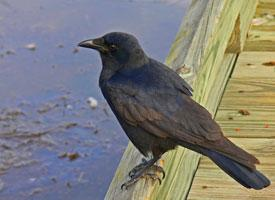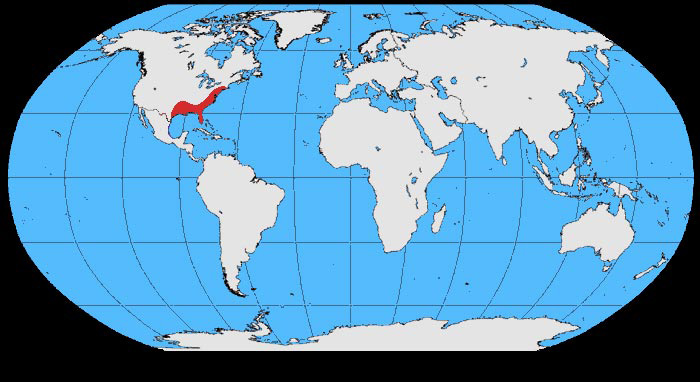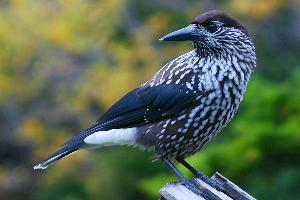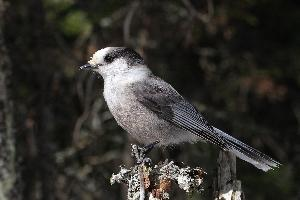
Váhy a míry
| Délka | od 36 do 41 cm |
|---|
Popis zvířete
The Fish Crow (Corvus ossifragus) is a fascinating bird species belonging to the crow family, known for its adaptability, intelligence, and distinctive vocalizations. It is primarily found along the southeastern coast of the United States, stretching from New Jersey down to Florida, and westward along the Gulf Coast to Texas. This species is slightly smaller than the American Crow (Corvus brachyrhynchos) with which it shares much of its range, but it possesses unique characteristics that set it apart.Physical Description:
The Fish Crow measures approximately 34 to 40 centimeters (13 to 16 inches) in length, with a wingspan of about 85 to 99 centimeters (33 to 39 inches). It weighs around 300 to 400 grams (10.5 to 14 ounces). Its plumage is predominantly glossy black, with a slightly purplish or greenish sheen that can be seen under certain lighting conditions. The bird's eyes are dark, and its beak and legs are black, contributing to its overall dark appearance. One distinguishing physical feature from the American Crow is its slightly smaller size and more slender build. The beak and tail of the Fish Crow are also proportionally smaller, which can be useful identification markers for birdwatchers.
Habitat and Distribution:
The Fish Crow is typically found in coastal areas, frequenting marshes, beaches, and riverside woods. It is a highly adaptable bird that has also made its way into urban environments, where it can be seen scavenging for food in parks and garbage disposal sites. The bird's natural habitat, however, remains closely tied to water bodies, reflecting its name and dietary preferences.
Diet:
As its name suggests, the Fish Crow has a diet that includes a significant amount of aquatic animals. It feeds on small fish, crabs, and other marine invertebrates. However, its diet is not limited to aquatic life; it is an opportunistic feeder that will consume a wide variety of foods, including insects, fruits, seeds, and even small animals. In urban areas, it has adapted to consume human food waste, demonstrating its versatile feeding habits.
Behavior and Vocalizations:
The Fish Crow is known for its intelligence and complex social behavior. It has been observed using tools and working in groups to find food. Its vocalizations are one of the most distinctive features, with a more nasal tone compared to the American Crow. The typical call sounds like a hoarse "uh-uh" or "ah-ah," which can be helpful in distinguishing it from its relatives.
Breeding:
Fish Crows are monogamous birds that form long-term pair bonds. They build nests in trees, often near water, using sticks and lining the interior with softer materials. The female typically lays 3 to 5 eggs, which she incubates for about 18 days. Both parents are involved in feeding and protecting the young, which fledge approximately one month after hatching.
Conservation Status:
The Fish Crow is currently not considered to be at risk. It has a large range and a stable population size. In fact, its adaptability to human-altered landscapes has allowed it to thrive in areas where other species might struggle. However, like all wildlife, it faces threats from habitat destruction and pollution.
In conclusion, the Fish Crow is a remarkable bird that embodies the adaptability and intelligence characteristic of the corvid family. Its presence along America's coastlines and increasingly in urban areas serves as a testament to its versatility and resilience. Whether observed in its natural habitat or in the heart of a city, the Fish Crow remains a symbol of the wild's enduring allure and complexity.
Mapa výskytu

Podobná zvířata
Nové fotografie zvířat
Top 10 zvířat
- Chinese water dragon (Physignathus cocincinus)
- Galápagos tortoise (Geochelone nigra complex)
- Dolphin gull (Leucophaeus scoresbii)
- Japanese macaque (Macaca fuscata)
- Colombian red howler (Alouatta seniculus)
- Sea urchins (Echinoidea)
- Moustached guenon (Cercopithecus cephus)
- Diana monkey (Cercopithecus diana)
- Common reed warbler (Acrocephalus scirpaceus)
- Common house mosquito (Culex pipiens)


